
Home
Mission
Overview of Project
Project Staff
Sponsors
Achievements
Checking, Illustrations
Upcoming Activities
Id and Species Lists
Protea Information
Protea Gallery
Growing Proteas
Interim Dist. Maps
Publications
Afrikaanse Inligting
![]()
Common Sceptres - Paranomus
Bredasdorp Sceptre - Paranomus abrotanifolius
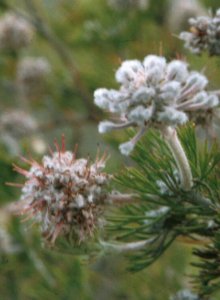 |
Habit: A much branched
shrub up to 0.9m tall Fire survival: Killed, only seeds survive Sexual system: Both sexes in each flower Flowers: May - December Pollinator: Insects Fruit: Released 2 months after flowering Seed dispersal: Ants Seed storage: Underground in ants nests Rarity status: Vulnerable, 10 populations are known Habitat: Sandstone sands, 140-1200m Distribution: Elim Flats and Potberg |
Smooth-leaf Tree Sceptre - Paranomus bracteolaris
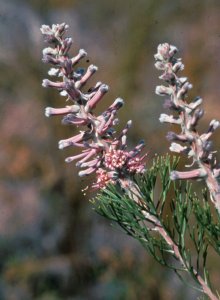 |
Habit: A much branched
shrub up to 2m tall Fire survival: Killed, only seeds survive Sexual system: Both sexes in each flower Flowers: August - October Pollinator: Insects Fruit: Released 2 months after flowering Seed dispersal: Ants Seed storage: Underground in ants nests Rarity status: Not threatened, extensive stands occur Habitat: Sandstone sands, 250-1300m Distribution: Bokkeveld escarpment to Koue Bokkveld and Olifants River Mountains |
Overberg Sceptre - Paranomus bolusii
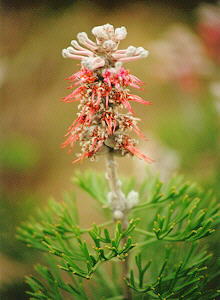 |
Habit: A much branched
shrub up to 1m tall Fire survival: Killed, only seeds survive Sexual system: Both sexes in each flower Flowers: June - November Pollinator: Insects Fruit: Released 2 months after flowering Seed dispersal: Ants Seed storage: Underground in ants nests Rarity status: Not threatened, extensive populations occur Habitat: Sandstone and Cederberg shales, 150-700m Distribution: Groenland, Riviersonderend, Babylonstoring and Klein River Mountains, Caledon and Swartberg |
Powder Sceptre - Paranomus candicans
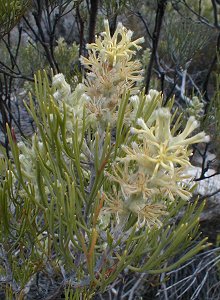 |
Habit: A much branched
shrub to 2m tall Fire survival: Killed, only seeds survive Sexual system: Both sexes in each flower Flowers: June - November Pollinator: Insects Fruit: Released 2 months after flowering Seed dispersal: Ants Seed storage: Underground in ants nests Rarity status: Not threatened, scattered plants in extensive stands Habitat: Sandstone sands, 600-2000m Distribution: Hex River Mountains to Langeberg |
Long-head Sceptre - Paranomus dispersus
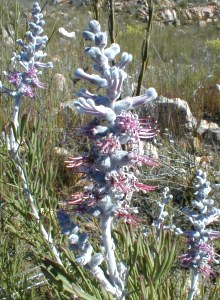 |
Habit: A much branched
shrub up to 1.5m tall Fire survival: Killed, only seeds survive Sexual system: Both sexes in each flower Flowers: All year round, mainly August - November Pollinator: Insects Fruit: Released 2 months after flowering Seed dispersal: Ants Seed storage: Underground in ants nests Rarity status: Not threatened, sometimes occurs in dense stands Habitat: Sandstone stands, 300-1200m Distribution: Groot Winterhoek to Riviersonderend to Outeniqua Mountains and Klein Swartberg and Rooiberg |
Rabbit-paw Sceptre - Paranomus lagopus
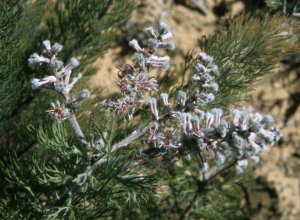 |
Habit: A much branched
shrub up to 1.3m tall Fire survival: Killed, only seeds survive Sexual system: Both sexes in each flower Flowers: September - November Pollinator: Insects Fruit: Released 2 months after flowering Seed dispersal: Ants Seed storage: Underground in ants nests Rarity status: Not threatened, occurs in dense isolated stands Habitat: Sandstone sands, 200-1100m Distribution: Koue Bokkeveld, Groot Winterhoek and Elandskloof Mountains |
Palmiet Sceptre - Paranomus sp nova
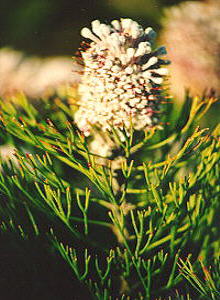 |
Habit: Rounded shrub to 1m
tall Fire survival: Killed, only seeds survive Sexual system: Both sexes in each flower Flowers: August - November Pollinator: Insects Fruit: Released 2 months after flowering Seed dispersal: Ants Seed storage: Underground in ants nests Rarity status: Endangered, only one safe site remains Habitat: Shale soils suitable for fruit orchards, 200-300m Distribution: Palmiet River Valley south of Elgin |
Kogelberg Sceptre - Paranomus spicatus
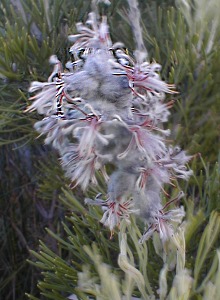 |
Habit: A shrub up to 1m
tall Fire survival: Killed, only seeds survive Sexual system: Both sexes in each flower Flowers: September - November Pollinator: Insects Fruit: Released 2 months after flowering Seed dispersal: Ants Seed storage: Underground in ants nests Rarity status: Rare, scattered plants in about 5 populations Habitat: Sandstone sands, 0-300m Distribution: Hottentots-Holland Mountains from Sir Lowry's Pass to Kogel Bay to Rooiels |
Back Sceptre Gallery